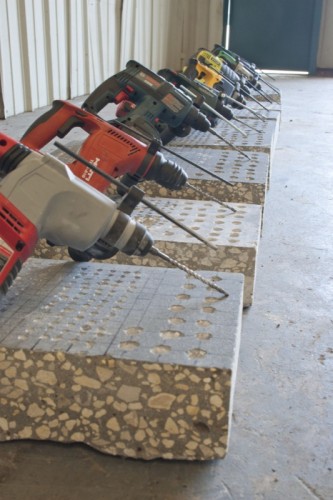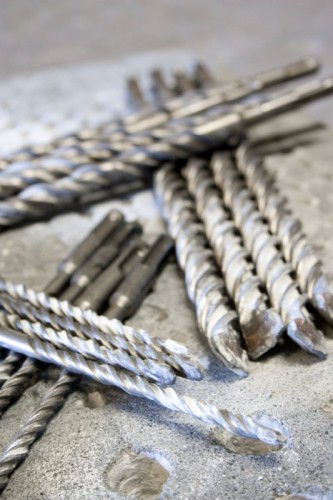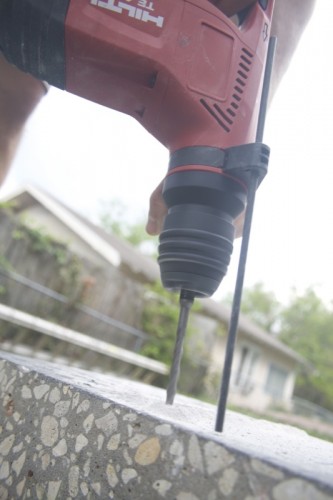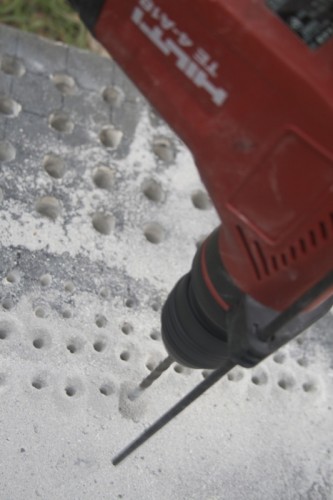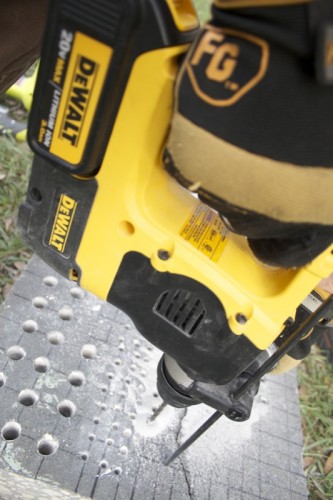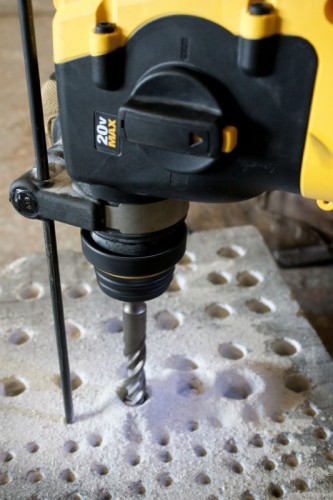Pulling over a mile worth of Cat5e wire is a challenge in and of itself, but doing it all inside a two-story concrete and block building takes it to a whole new level. As with most of the reviews I do for Pro Tool Reviews, I tend to execute the real-world testing portion of the article around a project or task at hand. This time, I needed to provide hardwired Internet cable drops to over 60 locations inside an education facility. The real trick was that all the wire had to be concealed—either within the walls or overhead. Back in the 1950’s, when this building was originally constructed, everything was either solid formed concrete or block that was filled. If you want to form a mental picture, figure this place is built pretty much like a big bunker. If there’s an F5 class tornado in town, this is the place you want to run to for shelter. It’s tasks like this that make you want to do a cordless 18V SDS Plus rotary hammer round-up so you know which tools are the best.
The holes we drilled ranged from 1/4” all the way up to 1” in diameter with depths between 1 inch and 18 inches deep. On the deeper holes, we were penetrating some of the main walls to get from one room to another. Needless to say, there was acn ample amount of work with which to employ the collection of eight cordless 18-volt SDS-Plus rotary hammers I had on-hand for this cordless 18V SDS Plus rotary hammer round-up review.
Rotary Hammers have been around for a long time, but with the rise of lithium-ion battery technology, cordless models are quickly becoming powerful enough to find themselves as a regular staple in every tradesman’s tool bag. Most commercial contractors should already be very familiar with their use, but if you haven’t been in the market for a new tool in a while, you may not have realized that the new tools are getting more compact. This is primarily thanks to greater energy density and increased capacity in the newer battery technologies. With a rise in the use of concrete in the residential construction market, many contractors are finding the need to update their tools to keep up with materials. If I had to guess, this has been the driving force behind an apparent new interest in the development of these powerful, cordless tools.
Rotary Hammers vs. Hammer Drills
For those who are on the fence as to whether you actually need to get a rotary hammer, realize that there are significant differences between your hammer drill and these tools. While both will drill holes in concrete and each uses both a spinning motion and hammer action, that’s where the similarities end. A quick summary would be that your hammer drill slowly chips concrete and a rotary hammer pounds it. A typical hammer drill will provide a greater number of hits per minute than a rotary hammer, but that rotary hammer will deliver a greater amount of force with each blow.
Internally, a hammer drill uses a mechanical cam-action drive that delivers rapid impacts, but it also requires the user to exert a reasonable amount of physical effort on the drill in order to make the holes. Rotary hammers work much more like a hammer and chisel. Using an electro-pneumatic mechanism that employs a piston and pin system, a rotary hammer transfers the tool’s energy to the workpiece in a much more effective manner. (For an even more detailed explanation, read our “How’s It Work: Rotary Hammers” article.) These hammers have a lower BPM (blow per minute) but offer a higher impact energy and transfer less energy to the user, so you don’t have to exert as much manual force to make the holes. In short, a hammer drill is great for the occasional hole, but if you’ve got a lot of concrete drilling to do, a rotary hammer should be your go-to tool.
Softening the Blow: Vibration Reduction
Even though a rotary hammer’s mechanism, by nature, transfers more of the energy to the tool—and less to the user, many of the tools that we reviewed provide some kind of additional vibration dampening. This makes long hours of drilling even more bearable—heck, almost enjoyable when compared to the jolting experience you would get from a hammer drill. Of note, DeWalt’s DCH213 allows the entire hammer mechanism to move within the body of the tool, detaching it from your hands. Milwaukee’s 2605-20 uses a mechanical vibration reducing grip that softens the blows, and Makita’s shock absorbing handle serves to protect the battery housing, which is a consideration I hadn’t thought of but ends up making a lot of sense.
Bits
All of the rotary hammers in this review use SDS-Plus bits. SDS-Plus rotary hammers are typically used to drill holes for anchors with sizes ranging from as little as 5/32” up to a maximum of 1 inch in concrete. Some of the tools in our test were rated to 1 inch, but a majority were specified to handle a maximum of 5/8 inch. Nearly all of the tools were spec’d to drill a particular amount of holes in concrete using 1/4″ bits. While some tools–l came with bits (the Hilti TE 4-A18), in a desire to keep a level playing field, each tool was provided with a brand new identical bit before we began testing. For this review we chose 1/4” x 6” and 5/8” x 6” Bosch Bulldog SDS-Plus Standard Concrete bits provided to us by Lowe’s Home Improvement.
Concrete Testing Specs
Not all concrete is the same, so if I wanted to be able to replicate our drilling tests later the material used had to have some level of consistency. After talking to some of the guys who work with us on our other concrete tool reviews, we decided on high-strength, ASTM-C150 Type III with Aggregate that meets ASTM-C33. It was cured for over 60 days to achieve an acceptable hardness. There was 4” welded wire mesh set at 3” below the finished surface to hold it together since we were planning to fill it full of holes. I used this for all of the time trials and endurance tests because I knew it would be a material we could replicate for future testing as well.
Preparation is Everything
Like a kid on Christmas Day, I eagerly opened up each box and tool case to check the tools. Since these are cordless tools, the first thing I did was take out the chargers and put in the batteries to get them ready. The charging times varied, none of the products taking more than an hour. Some, like the Makita, took just 30 minutes. All of the chargers feature lights that give the current status of the charge.
Every one of the tools comes standard with a side handle and a depth adjustment guide rod. All of the rods were metal except for the one that came with the Hitachi, which tended to bend during use. Some tools arrived in soft sided storage bags (Makita, Bosch) and others in plastic tool cases (DeWalt, Hilti, Hitachi, Milwaukee). Some tools were bare-tool only, and we picked up batteries and chargers separately (Ryobi, Metabo). In preparing the tools for use, we used Hilti supplied bit grease on the ends of all the bits before inserting them into the chucks. We did all of our initial testing, including checking sound levels, weighing the tools and using our digital tachometer to check the top end free spin RPM. Half of the rotary hammers we tested (Bosch, DeWalt, Makita and Milwaukee) have chipping functions, but since that list didn’t include all the models tested, I didn’t factor it into my results. It’s still a great feature that might be important to you if, for example, you find yourself having to widen the space for an outlet or switch box or wanting to remove small tile with a chisel bit.
All of the rotary hammers do, however, have the ability to select between their drilling and hammer drilling modes. By design, the primary function of rotary hammers is drilling in concrete, so I focused solely on this aspect of the tool for all of my recorded tests.
Test 1: Practical Run-time
Total Numbers of 1/4” Diameter x 1-1/2” Deep Holes on a Single Charge
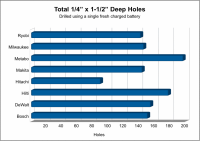
After every 15 holes, each tool was given a 10 minute rest before starting the next round of holes. The time break between holes is so that the battery and the tool have some time to cool down. This was done to better match real-world use, while also maximizing the potential number of holes that each tool could drill. It also helped avoid testing the electronic shut off of the tool as opposed to the actual maximum run-time. To minimize the difference in user technique, four different reviewers were enlisted. Each time a series of holes was drilled, I rotated them so that a different user picked up where the last had stopped. When looking at the results, you can see that the Metabo did 197 holes, and the Hilti did 178 holes, making them the leaders in this particular test. The Hitachi had the lowest hole count at only 90, and it was almost a perfect level playing field for the remaining five rotary hammers with just a 13 hole spread between them.
Surprisingly, the rated battery amp hours (Ah) didn’t really give an advantage in this test. In fact, one of the best performers, the Hilti TE 4-A18, only had a 3.3 amp hour battery.Similarly, many that came in the middle five were both three and four amp hour models. The Hitachi DH18DL, while labeled a rotary hammer by the manufacturer seemed to perform more on par with a hammer drill with an SDS Plus chuck attached. It had the highest amount of user felt vibration, and it had the highest BPM spec. In fairness to Hitachi, however, this model seems to be a bit dated, and we wouldn’t be surprised to see an updated model come to market soon. In doing this test, we drilled over 1200 holes during the course of several days—more than enough time to get comfortable with the features and performance of each of the rotary hammers.
Test 2: Time Trials
Average Time to Drill 1/4” Diameter x 3” Deep Holes
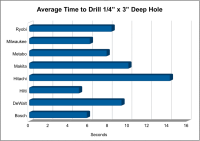
What I found really interesting was that it was hard to find any combination of specifications, or even a correlation to my own results that made any one tool predictably superior in this category. The speedy Hilti TE 4-A18 had the fastest time with an average of just 5.1 seconds to complete the hole, but was followed up quickly by both the Bosch RHH181 and Milwaukee 2605-20. While there was a 9.2 second gap between the fastest and slowest tools, all of the tools except one fell within a 5 second window.
Test 3: Heavy Duty Use
Total Numbers of 5/8” Diameter x 3” Deep Holes on a Single Charge
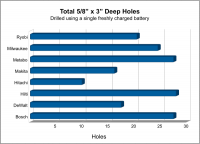
The results of this test seemed to reinforce that when it comes to endurance testing, battery amp hours have a noticeable effect on the quantity of holes drilled. The DeWalt DCH213, the Makita LXRH01 and the Hitachi DH18DL were all supplied with 3.0 amp hour batteries, and all three did the least number of holes. We suspect that had higher amp hour batteries been available, the DeWalt and Makita would have seen similar numbers to the other tools with the higher capacity batteries. The top three performers were clearly the Bosch RHH181, the Hilti TE 4-A18 and the Metabo BHA 18 LTX, all of which had less than half a hole difference in the quantities completed. Close behind was Milwaukee’s 2605-20, only lagging by a mere three holes.
Conclusion
Looking at this collection of 18 volt cordless rotary hammers, it’s evident that competition in the marketplace is providing lots of choices for lightweight, feature-rich and more durable tools. I continue to really appreciate details like LED lights for better visibility and anti-vibration technology, so you can work more comfortably. Depending on your application, you also want to keep your eyes open for dust-collection systems that are compatible with these new rotary hammers. This can be especially helpful when drilling overhead or on job sites where dust needs to be controlled.
Editor’s note: PTR will actually be reviewing dust collection vacuum products from Makita and others in next month’s issue.
In an attempt to try and quantify all of the testing I performed, I took the raw scores of the three tests and turned the values into percentages, adding them together and taking the average. Using this methodology, the Hilti came in at 97, the Metabo was second at 88, and the Bosch trailed by just one point at 87. Milwaukee was a respectable 81, and the rest of the tools received 69 or less points. If you look over the individual comments for each tool, you’ll see that the final tally doesn’t necessarily tell the whole story. With the exception of the Hitachi, which has been on the market a long time and is simply due for an update, it’s not hard to make at least a modest case for each of the tools tested.
Tool By Tool
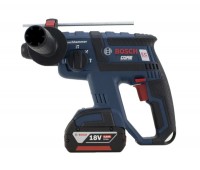
The Bosch RHH181 is a brand new model that built on the success of the RHH180 by adding a new chipping mode to the dial and a brand new 4.0 Ah battery. According to our testing, this tool is the quietest of the bunch, while in operation, and is also one of the lightest. This German-built rotary hammer was a pleasure to use with many nice features like a built-in LED work light, easy to adjust depth gauge and a brushless motor. It’s also extremely compact. Feedback from our testers had this rotary hammer coming up as one of the overall favorites to use. According to our performance testing, those impressions were spot-in, since it came in a tight third place.
Pros: Lightweight & compact, quiet, chipping mode, brushless motor
Cons: None to report
Price: $500 (Kit with 2 batteries & charger)
Verdict: The German sports car of rotary hammers
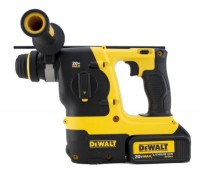
The DeWalt DCH213 incorporated some of the best anti-vibration characteristics out of all the drills in the round-up. User fatigue would be at an all time low if more contractors would use this rotary hammer. DeWalt offers some serious performance in concrete drilling, and it’s not surprising since this tool is made in the Czech Republic. All through Europe, and in most parts of the world, concrete is the normal building material. The design of this tool makes it apparent that it’s made for folks that do a lot of concrete work. Features that make this tool a sensible choice is its low noise, the built-in LED work light and the selectable chipping mode on the side dial. Had this rotary been supplied to us with the new 20V Max 4.0 Ah batteries, we suspect that its final performance score would have been significantly higher.
Pros: Great anti-vibration technology, LED work light, chipping mode
Cons: Slight top-heavy feel
Price: $470 (Kit with 2 batteries & charger)
Verdict: Performance that does not come at the loss of operator comfort
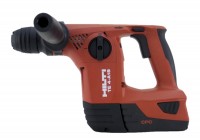
The Hilti TE4-A18 sets the benchmark for other manufacturers to beat when it comes to performance. When using this tool, it felt as if the bit just melted into the concrete. Operator effort seemed almost optional when using this tool. Simply start the bit, and the Hilti did the rest. We found it ironic that its 3.3 Ah battery was able to outdo every 4.0 Ah battery powered tool in the review. Hilti has been in the concrete tool business since the 1940′,s and it’s evident in the refinement of their tools. This rotary hammer will be an investment, but it came in at the top of our performance testing and is worth every penny.
Pros: Lifetime warranty, amazing performance
Cons: Limited availability
Price: $650 (Kit with 2 batteries & charger)
Verdict: Best overall performer money can buy
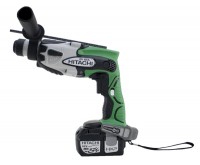
When compared to the rest of the rotary hammers in this review, the Hitachi DH18DL seems to be in dire need of an update. While it’s the most lightweight and least expensive kit in the round-up, it also comes with 3.0 Ah post-style lithium-ion batteries and didn’t have the same drilling power as the rest. The drill’s form factor feels much more like a hammer drill with an SDS-Plus chuck attached. Felt vibration was high, and extra pressure was required to make the holes in our testing. We suggest waiting until the next iteration of this tool before springing for this 18V cordless Hitachi rotary hammer.
Pros: Lightweight, Inexpensive
Cons: Least powerful, Short run time, No battery level gauge, Plastic depth guide rod
Price: $280 (Kit with 2 batteries & charger)
Verdict: Old timer trying to play with the young guns
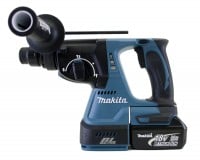
Some might look at the Makita LXRH01 in its kit form and notice the price seems a little high. (You can purchase it tool-only as well.) There’s a reason for this. While it wasn’t reviewed it in this article (Look for it next month.), Makita’s LXRH01 rotary hammer kit actually comes with a full HEPA cordless vacuum system that can be attached to the drill. This setup is pretty sweet and is really necessary for some dust-critical jobs. Given where the numbers landed with Makita’s 3.0 Ah battery, we suspect that with 4.0 Ah batteries this rotary hammer would give any of our top contenders a run for their money. Also notable, the LXRH01 comes with a brushless motor and a chipping function.
Pros: Cordless HEPA vacuum system included with kit, brushless motor, chipping mode
Cons: Not supplied with 4.0 Ah batteries, no battery level gauge
Price: $670 (Kit with 2 batteries, charger & HEPA vac attachment)
Verdict: Full concrete drilling and dust collection solution in one slick package
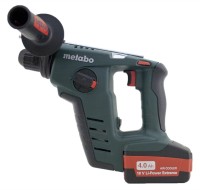
To many in the U.S. market, the name Metabo might be unfamiliar. Go to the rest of the world, however (especially in Europe), and you’ll find that this German company makes some top-notch construction tools. The Metabo BHA 18 LTX was the second best overall performer in our tests. I appreciated the small details like the bent end guide rod, which made drilling to the proper depth incredibly easy and accurate. Curiously, the battery has to be removed to see the level gauge, and it was the only tool in the group that would not stand up on its own. In the grand scheme of things, these little idiosyncrasies weren’t a big deal once you factor in the ridiculous performance that this rotary hammer delivers. I have a feeling that in the coming years Metabo is going to be a more familiar name in the commercial construction market here in the States.
Pros: Top performer in our 1/4” x 1-1/4” hole drilling test, best depth gauge
Cons: Limited availability in the USA, must remove battery to see remaining charge, short warranty
Price: $776 ($349 tool, $189 battery [x2], $49 charger)
Verdict: Solid German-engineered performance
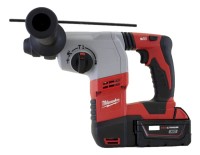
If beefy-feeling, performance-oriented power tools are what you like, the Milwaukee 2605-20 is probably your best choice. Couple this rotary hammer with one of their new 4.0 Ah battery packs, and you can expect to get some work done. With consistently high scores in our three drilling tests, this tool displayed that it’s ready to do some work. The built-in anti-vibration control was appreciated, but it didn’t help negate that this tool was also the heaviest of the bunch. Inside there’s a mechanical clutch that protects the motor if the bit binds, and there are electronics on-board to protect the battery and tool if necessary. This is a great rotary hammer that will definitely deliver heavy-duty service.
Pros: Chipping mode, long warranty, EZ adjust depth guide
Cons: Heavy
Price: $450 (Kit with 2 batteries & charger—4.0 Ah battery has to be bought separately)
Verdict: The rotary hammer that ate heavy-duty for lunch
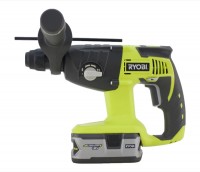
The Ryobi not only kept up with the pack but was actually in the middle during our concrete drilling tests. With a compact and lightweight body and 4.0 Ah batteries, the Ryobi really was the surprise underdog performer. With only a $99 dollar bare-tool price, it’s as close to a no-brainer as you can get if you’re already flush with other Ryobi One+ tools. You won’t be disappointed.
Pros: 4.0 Ah battery, very low bare-tool price, lightweight
Cons: Only available as a bare tool
Price: $307 ($99 tool, $89 battery [x2], $30 charger)
Verdict: Value leader underdog


